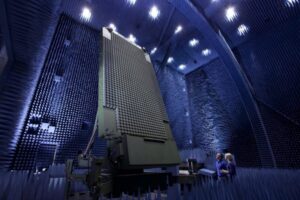SYRACUSE, N.Y. – Lockheed Martin [LMT] has said its “actively working” with four countries interested in the company’s new TPY-4 ground-based air surveillance radar, which recently completed initial testing and will be handed over to the U.S. Air Force soon in the lead up to the operational test and evaluation period starting next summer.
Steve Allen, Lockheed Martin’s program director for ground-based air surveillance, told reporters here last week the company has had “technical discussions” with the group of international partners interested in TPY-4, with a couple of the countries “very close to the [Request for Proposals] stage.”

The U.S. Air Force in March 2022 selected Lockheed Martin for its Three-Dimensional Expeditionary Long-Range Radar (3DELRR) program to replace the service’s legacy TPS-75 radar, with the company now under contract to build the first six radars. The 3DELRR program includes options to potentially provide up to 35 of the new radars (Defense Daily, March 11 2022).
Allen noted the testing that recently concluded at the company’s Cazenovia, New York site near here was conducted with the the first self-funded production representative unit radar.
“This is the first step before we hand [the radar] over to the Air Force for them to do all of their operational test and evaluation. And really, what they’re going to do is they’re going to take [the TPY-4] and push it to its limits,” Allen said.
Open-air testing over the last year with the TPY-4 radar has included assessing probability of detection, demonstrating identification and tracking of targets, target tracking and testing of latency requirements to ensure system performance.
“The way we were able to get through testing of this radar so quickly is because we invested in the first production unit prior to being under contract. Had we not done that, we would not be in a position where we’d be at the operational test and evaluation next year,” Chandra Marshall, Lockheed Martin’s vice president of radars and sensor systems, told reporters during a media visit to the company’s facility here.
Norway last November signed a contract with Lockheed Martin to supply eight of its TPY-4 radars as the country’s future air surveillance capability, with options for three additional radars, becoming the first international customer for the system (Defense Daily, Nov. 18).
Officials from Norway visited the Cazenovia site in September to view TPY-4 testing, Allen confirmed, with the country expected to receive its first radar by end of 2025 and deliveries to be completed by 2030.
Allen noted there are now three TPY-4 radars currently in production for the U.S. Air Force at the manufacturing facility near Syracuse, with the company working toward a goal of building each radar in a six to eight week timeframe.
Ahead of the Air Force starting operational test and evaluation with the TPY-4 at Eglin Air Force Base in Florida around June 2024, Allen said Lockheed Martin will continue backend process testing and working on the system’s algorithms for tracking and threat detection.
“What we’re really looking for is how do we accelerate the test program so we can get the capability out to the Air Force faster,” Allen told reporters.
Marshall cited the TPY-4’s software-defined architecture as allowing for more rapid, seamless upgrades as the Air Force’s mission evolves for emerging threats.
“One of the things that we’ve really focused on in all of the new products that we’ve been developing is the ability to do [upgrades]…without changing the hardware [and] doing it through software upgrades. As you can imagine, once you start to change the hardware, it gets very costly for customers to be able to pace the threat. So having built it into our architectures from the get go and just introducing software to bring out additional capability really allows us to go faster for our customers with the capability that they’re buying,” Marshall said.
Last December, Marshall told reporters that over 30 different potential customers had visited with the company over the prior six months to see the TPY-4 radar perform live tracking (Defense Daily, Dec. 1 2022).
A Pentagon Inspector General audit released in August found that acquisition missteps during the Air Force’s Middle Tier of Acquisition (MTA) rapid prototyping effort for 3DELRR delayed the fielding schedule for the new radar (Defense Daily, Aug. 30).
Marshall said the report was related to the Air Force’s efforts prior to the downselect for 3DELRR and not the company’s work on the program since then.
“That did not impact the timeline as far as our award,” Marshall told reporters.